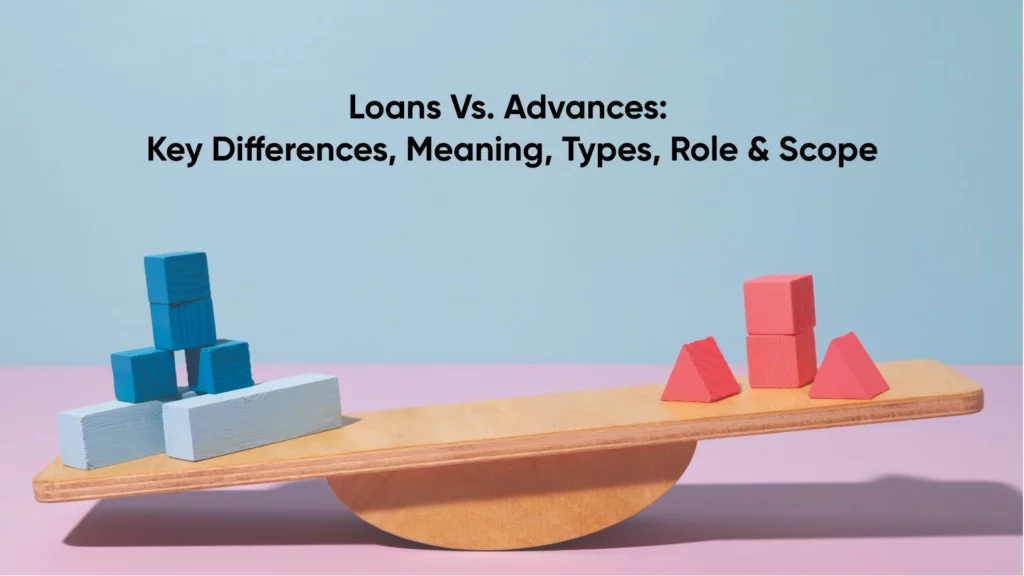Loans vs. Advances: Defenition, Meaning, Key Differences, Types

Loans and advances are financial tools that provide immediate funds to individuals or businesses during times of need. They are designed to offer short-term financial support, especially when there’s a sudden shortage of cash. By bridging the gap between expenses and income, loans and advances help manage emergencies, unexpected bills, or other urgent requirements without disrupting daily life. Whether it’s a medical emergency, bill payment, or cash flow issue, these options act as a quick and reliable solution to ease financial stress.
Table of Contents
ToggleWhat are Advances?
An advance loan is a sum of money that banks and other financial organizations give to people or companies to cover their immediate needs. These advance loans are usually given to borrowers as working capital to help with regular costs like salary and wages. Such loans advances are essentially a type of credit designed to meet short-term financial needs. It is meant to be used temporarily to take care of urgent financial needs. Advance loans provide quick access to funds, helping both businesses and individuals during financial challenges or unexpected expenses. They serve as an important tool for better cash management in times of need.
What are Loans?
When one borrows money from a lender can be a bank or NBCF and agrees to pay back the borrowed sum plus interest within a specific period are called loans. They are utilized by people, businesses, and governments to finance various expenses, investments, and projects. Loans provide access to funds that individuals or entities may not have readily available, allowing them to make purchases or investments that would not be possible.
8 Major Difference Between Loans And Advances
Let’s dive into major loans and advances differences in this section:
| Aspect | Loans | Advances |
| Eligibility | Eligibility included credit score, income, employment status, and existing debt obligations | Eligibility differs based on the lender and the type of advance. |
| Interest Rate | Usually has lower interest rate | May have higher interest rates, especially without collateral |
| Purpose | Used for various purposes such as home purchase, getting a new vehicle education, or business startup | Often used for short-term financing needs like covering operating expense, purchasing inventory etc |
| Repayment Terms | Fixed repayment terms with regular installments with specific period | More flexible personal loan repayment terms, often shorter timeframes |
| Risk | Higher risk for lenders, especially unsecured loans | May involve lower risk, particularly if collateral is involved. |
| Processing Time | Longer processing time due to background checks. | Quicker processing time with minimal documentation |
| Legal Formalities | Formal legal agreements outlining terms and conditions | May involve simpler agreements |
| Collateral | May require collateral, especially for larger loan | May or may not require collateral, depending on the type of advance. |
Types of Loans and Advances
Understanding loans and advances meaning with loans and advances difference is essential for managing personal and business finances:
Types of Loans
Loans can be best classified into two major categories: Secured and Unsecured Loans.
Secured Loans:
Secured loans are loans where borrowers keep assets, like property or vehicles, as collateral to obtain funds from a lender. This collateral acts as security for the loan, lowering the risk for the lender. If the borrower fails to repay, the lender can seize the collateral to recover the debt. Because of this security, secured loans typically have lower personal loan interest rates. Some of the examples include home loans, car loans, gold loans, etc.
Unsecured Loans:
Loans that don’t demand collateral from the borrower are known as unsecured loans. You are eligible for unsecured personal loans based on your credit history and ability to repay. Credit card debt, school loans, and personal loans are a few types of unsecured loans. Unsecured loans are easy to opt for based on your eligibility, though the interest rates are higher.
Types of Advances
Types of Loans Advances are different based on one’s need. Here are some common types:
Overdraft
With an overdraft, people can take out more money than they have in their bank account, up to a certain limit. It offers a short-term personal loan borrowing option, allowing the account holder to access more funds up to a certain limit, even if they are short on a bank balance. Interest is only charged on the amount overdrawn. Overdrafts are frequently used to fill short-term financial needs, such as paying bills or meeting unexpected needs before receiving income. While overdrafts offer immediate cash needs, borrowers should be aware of associated fees and interest charges.
Cash Credit
Cash Credit is when the bank allows you to borrow funds up to a specific amount, based on their creditworthiness, to meet urgent needs. Interest is charged on the amount used, and repayments are flexible. It helps borrowers to withdraw funds up to a certain credit limit based on their creditworthiness and collateral. Borrowers can withdraw money as needed and repay it at their own pace.
Payday Loans
Payday loans are short-term loans that are normally used to pay for expenses up until the borrower’s next payday. Although they are frequently quick and simple to get, their interest rates are far higher than those of traditional loans. These loans are often used by people who have sudden financial requirements or unforeseen bills every day. While payday loans provide quick access to cash, they can lead to a debt cycle if not handled properly. Borrowers often repay the loan, including fees and interest, when they receive their next salary. Borrowers may become locked in a cycle of borrowing to cover expenses, resulting in increased debt. Hence, we need to be very careful of the consequences associated with such loans.
Salaried Loans
If you’re a salaried individual who is out of cash and requires financial assistance, an advance salary loan can be your perfect solution. One of the best parts about this loan is that you don’t even need to visit any financial institution. A salary loan online is a short-term urgent personal loan offered by online lenders to help you meet any of your financial requirements. You can borrow the money you need and pay it back after you receive your salary or in the form of small installments called EMIs. There are many salary loan apps that can provide you with instant access to funds. Zype is an app that offers a maximum personal loan of up to ₹5 lakhs. Based on your profile, you can get approved for a loan by downloading the Zype app in less than 60 seconds.
Role of Loans and Advances
Knowing the types of loans and advances is not enough. Let’s also understand the difference between loans vs advance based on their role which is crucial for effective financial management and decision-making. Here’s why:
Financial Resource: Loans and advances are important financial tools because they allow individuals and organizations to access funds. Loans and advances help to achieve your personal goals such as buying a house. Loans and advances help to fill the gap between the current financial situation and future goals. By providing various repayment alternatives and low-interest rates, financial institutions enable borrowers to successfully manage their money while pursuing their goals.
Money Management: Loans and Advances helps in managing money with monthly installments. One can easily manage their money with the help of monthly installments which will not cause issues for finances Loans provide a lifeline to individuals during times of financial hardship or when pursuing key life goals such as acquiring a home, financing education, or covering unexpected bills. Similarly, firms use advances to fund business plans and engage in innovation or other business growth initiatives.
Funding Investments: Loans and advances promote investments in a variety of projects, allowing organizations to expand operations, engage in new technologies, and pursue growth prospects. Individuals can also utilize them to fund schooling, acquire assets, or engage in personal development. Loans and advances are the feasible options to fund investments in personal growth and long-term aspirations. Educational loans, for example, allow people to pursue further education and gain useful skills, so increasing employment opportunities.
Short-term and Long-term Goals: Loans and advances offer flexible finance choices for both short-term and long-term projects. These financial instruments cater to a wide range of needs, assisting borrowers in effectively achieving their objectives Whether it’s handling immediate financial needs or setting the groundwork for future success, these financial instruments help borrowers at every stage of their path to maintain stability.
Loan vs Advance – What is the scope?
Financial Flexibility: Loans and advances enable individuals and businesses to get capital for a variety of purposes, including personal expenses, business investments, and emergency necessities. This financial flexibility enables borrowers to meet immediate financial needs or take advantage of investment possibilities without relying primarily on existing resources. Loans and advances allow borrowers to better manage their finances and respond to changing circumstances by making funds easily available.
Business Expansion: Loans and advances are critical sources of finance for firms looking to expand operations, invest in new equipment, or introduce new products or services. This access to external capital allows businesses to pursue growth prospects that might otherwise be unattainable due to limited resources. Loans and advances enable firms to develop their market presence, compete more effectively, and achieve long-term sustainability in their industries by providing the required financial support.
Personal Development: Individuals can use loans and advances to fund education courses, training programs, or personal development projects, allowing them to improve their talents and explore career advancement. Whether individuals want to enhance their education, learn new skills, or pursue professional certifications, access to financing can help them invest in their personal growth and development. Loans and advances enable people to pursue educational or vocational goals that match their interests and aspirations by funding tuition, course materials, and other relevant expenses.
Loan vs advance: Which one is better?
Loans vs Advances: It is important to make the right choice. Getting information about different types of loans and advances can be useful, but how do you know which one is better? Let’s look into the major factors that will help you to make an informed choice.
Understanding the Differences: Loans and advances are distinct financial tools, each with its own set of characteristics and benefits. Loans traditionally include borrowing a lump sum amount with a specified repayment schedule and interest rate, whereas advances provide instant access to smaller sums of money, frequently with shorter repayment terms and higher rates.
Assessing Needs: Prioritize your most important financial needs by identifying urgent expenses, you can focus on securing immediate funding solutions, such as short-term advances or working capital loans, to address these needs.
Considering Repayment Terms: It’s crucial to note that loan advances have payback requirements, which include repaying the principal plus interest. Repayment terms are different for both loans and advances. Loans have a fixed repayment period, i.e., there will be specific tenure for loans. Comparatively, advances are more flexible and can be repaid at any time.
Exploring Lending Options: Whether you want a loan or a cash advance, you should approach reputable banks or non-banking financial firms (NBFCs) for financial assistance. These organizations will carry out extensive due diligence to see if you are eligible and ensure responsible lending practices.
Evaluating Flexibility: While loans give stability through specified payback terms, advances provide greater flexibility by allowing for quick disbursement of money and shorter repayment durations. Depending on your demands and urgency, you can select the best choice for your financial requirements.
Conclusion
When deciding between a loan and an advance, careful analysis of your financial situation and goals is essential. Understanding Loans and advances meaning and getting deeper insight into loans and advances difference will allow you to make an informed decision. Choosing the correct instrument for your funding needs is critical. Advances are an easy way to meet short-term personal loan cash demands. Loans, on the other hand, are a better option if you need a greater sum and prefer to repay in installments. Making the right decision allows for a smoother financial path, ensuring that your borrowing matches your financial goals and capabilities.
Frequently Asked Questions
Loan advancement refers to the disbursement of a loan amount to a borrower, either partially or fully, based on agreed terms for a specific financial need or purpose.
Loans usually involve a fixed principal, interest rate, repayment tenure, and periodic EMIs. They can be secured or unsecured and are used for purposes like education, business, or emergencies.
Advance money refers to funds given ahead of time for goods or services. It acts as a prepayment and may or may not be refundable, depending on the agreement.
Common forms include personal loans, home loans, education loans, overdrafts, cash credits, and salary advances. They vary based on purpose, repayment terms, and whether collateral is required.
“In advance” means something is paid, given, or done before the due time—such as advance rent, advance salary, or prepayment for a service or product.
Advances are payments or funds given ahead of schedule, often to employees or vendors, which are later adjusted against future payments or services rendered.
Yes, both loans and advances typically attract interest, though rates may differ. Some employer advances may be interest-free, while most bank-provided ones include interest costs.
Yes, loans and advances can be either secured (backed by collateral) or unsecured (based on creditworthiness), depending on the lender’s policy and the borrower’s profile.
In accounting, loans and advances listed as current assets represent short-term amounts receivable from customers, employees, or other parties, usually expected to be recovered within a year.













